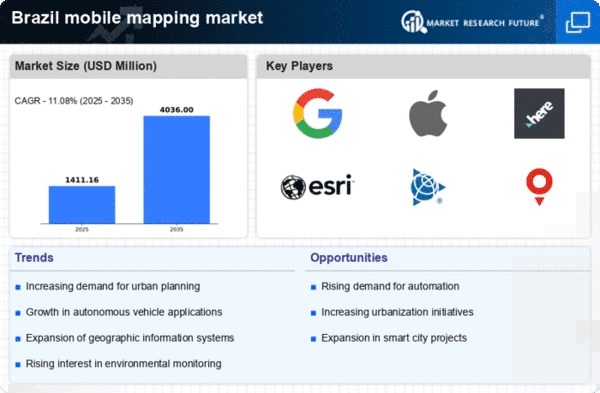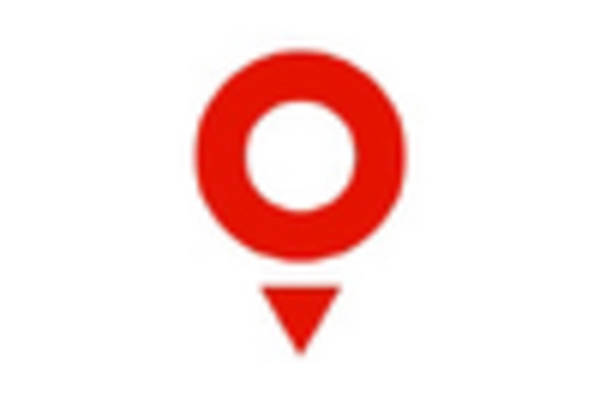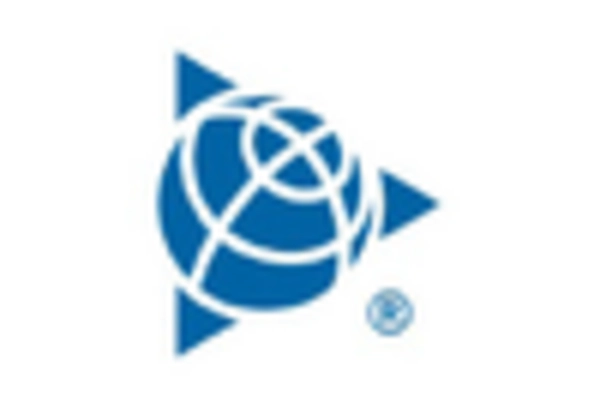Growing Urbanization
The rapid urbanization in Brazil is a pivotal driver for the mobile mapping market. As cities expand, the demand for accurate geospatial data increases, facilitating urban planning and infrastructure development. In 2025, urban areas in Brazil are projected to house over 85% of the population, necessitating advanced mapping solutions. This trend compels local governments and private sectors to invest in mobile mapping technologies to enhance navigation, traffic management, and public services. The mobile mapping market is likely to benefit from this urban growth, as stakeholders seek to optimize land use and improve transportation networks. Furthermore, the integration of mobile mapping with urban development projects can lead to more efficient resource allocation and better environmental management, ultimately contributing to sustainable urban growth.
Advancements in Mobile Technology
The continuous advancements in mobile technology significantly influence the mobile mapping market in Brazil. With the proliferation of smartphones and tablets equipped with high-resolution cameras and GPS capabilities, the accessibility of mobile mapping solutions has expanded. In 2025, it is estimated that over 90% of the Brazilian population will own a smartphone, creating a vast user base for mobile mapping applications. This trend encourages businesses and government agencies to adopt mobile mapping technologies for various applications, including real estate, tourism, and logistics. The mobile mapping market is poised to grow as these technologies become more integrated into everyday life, enabling real-time data collection and analysis. Additionally, the rise of augmented reality (AR) applications further enhances the potential of mobile mapping, providing users with immersive experiences and valuable insights.
Government Initiatives and Funding
Government initiatives and funding play a crucial role in shaping the mobile mapping market in Brazil. The Brazilian government has recognized the importance of geospatial data for national development and has initiated several programs to promote the use of mobile mapping technologies. In 2025, public investments in infrastructure projects are expected to exceed $50 billion, with a significant portion allocated to mapping and surveying activities. These initiatives not only enhance the capabilities of the mobile mapping market but also foster collaboration between public and private sectors. By providing financial support and resources, the government encourages innovation and the adoption of advanced mapping solutions. This collaborative environment is likely to stimulate growth in the mobile mapping market, as stakeholders leverage government resources to improve data accuracy and accessibility.
Rising Demand for Location-Based Services
The increasing demand for location-based services (LBS) is a significant driver for the mobile mapping market in Brazil. As consumers become more reliant on navigation and location-based applications, businesses are compelled to invest in mobile mapping technologies to meet these expectations. In 2025, the LBS market in Brazil is projected to reach $1.5 billion, reflecting a growing appetite for services that utilize geospatial data. The mobile mapping market stands to gain from this trend, as companies seek to enhance customer experiences through personalized services and targeted marketing. Moreover, the integration of mobile mapping with LBS can lead to improved operational efficiency for businesses, enabling them to optimize logistics and supply chain management. This demand for LBS is likely to drive innovation within the mobile mapping market, fostering the development of new applications and services.
Environmental Awareness and Sustainability
The increasing focus on environmental awareness and sustainability is influencing the mobile mapping market in Brazil. As concerns about climate change and resource management grow, there is a heightened need for accurate geospatial data to support environmental initiatives. In 2025, it is anticipated that investments in sustainable development projects will surpass $30 billion, with mobile mapping technologies playing a vital role in monitoring and managing natural resources. The mobile mapping market is likely to benefit from this trend, as organizations seek to utilize mapping solutions for environmental assessments, land use planning, and conservation efforts. Furthermore, the integration of mobile mapping with environmental monitoring systems can enhance data collection and analysis, enabling more informed decision-making. This emphasis on sustainability is expected to drive demand for innovative mobile mapping solutions that align with environmental goals.

















Leave a Comment